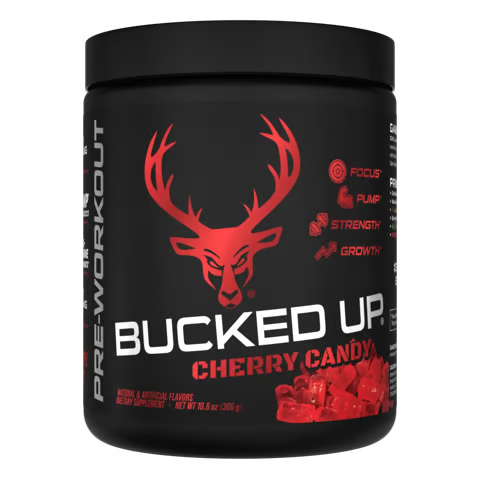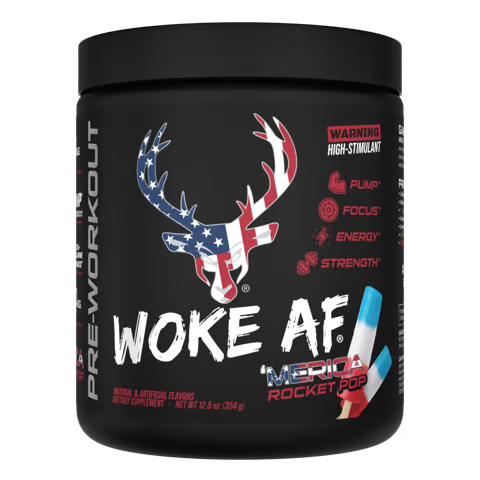Optimal hydration plays a vital role in your lifting performance. It directly impacts how well your pre-workout supplements, especially nitric oxide boosters, deliver results like better blood flow and muscle pumps. Without proper hydration, even the best pre-workout can fall short, leaving you with lackluster energy and endurance. This guide walks you through actionable steps to fine-tune your hydration strategy, enhance blood flow, and maximize every workout session with Bucked Up pre-workouts.
Check out Bucked Up pre-workouts for formulas crafted to support energy, focus, and pumps while complementing your hydration efforts.
Why Hydration Matters for Blood Flow and Nitric Oxide
Hydration forms the backbone of effective blood flow and nitric oxide production, both critical for lifting performance. When your body maintains proper fluid levels, nutrients and oxygen reach your muscles efficiently, enhancing endurance and strength.
How Hydration Supports Blood Volume
Your blood plasma, largely made up of water, decreases in volume when you’re dehydrated. This forces your heart to work harder to circulate blood. Losing just 3-4% of body mass through dehydration during exercise can reduce muscle blood flow and oxygen delivery. For a 180-pound lifter, losing 5-7 pounds of water weight in a session measurably impacts performance.
Dehydration also thickens blood, slowing circulation. Poor blood flow properties under dehydrated conditions strain the cardiovascular system, making it tougher for your body to support intense lifts.
Link Between Hydration and Nitric Oxide for Vasodilation
Nitric oxide widens blood vessels, improving flow to muscles during workouts. Hydration is essential for this process. Dehydration reduces blood flow, limiting the stress on blood vessel walls needed to produce nitric oxide. Without enough fluid, your body’s ability to expand blood vessels weakens, reducing the impact of any pre-workout booster.
How Dehydration Hinders Muscle Performance
Even slight dehydration stresses your body beyond just blood flow. A 3% loss in body mass from dehydration raises heart rate and vascular resistance during exercise, pulling energy away from muscle work. When hydrated, muscles get a steady supply of oxygen and nutrients. If fluids drop, delivery slows, and performance suffers.
Step 1: Spot the Effects of Poor Hydration
Understanding how dehydration impacts your workouts helps you address it before stepping into the gym. Many lifters start their sessions already at a disadvantage due to low fluid levels.
Early Signs of Insufficient Hydration
Thirst isn’t a reliable indicator of hydration needs. By the time you feel thirsty, your body is already struggling. Watch for these signs of low hydration:
- Lower energy or inability to maintain usual weights and reps.
- Weak muscle pumps, even with nitric oxide supplements.
- Higher resting heart rate due to reduced blood volume.
- Brain fog or lack of focus, as dehydration cuts blood flow to the brain during exercise.
- Dark urine, a simple clue to hydration status.
Calculate Your Sweat Rate
Everyone loses fluid at different rates during workouts. Knowing your sweat rate helps tailor your hydration plan. Here’s how to figure it out:
- Weigh yourself without clothes before training.
- Track any fluid you drink during the session.
- Weigh yourself again after, without clothes and after drying off.
- Use this formula: (pre-workout weight – post-workout weight + fluid consumed) divided by workout time in hours equals hourly sweat rate.
For instance, losing 2 pounds over an hour while drinking 16 ounces means a sweat rate of about 48 ounces per hour. This data guides how much fluid to replace during exercise.
Why Thirst Isn’t Enough
Thirst signals kick in after you’ve lost about 2% of body weight in fluids, when blood volume is already down. Dehydration’s impact worsens in hot environments. Serious lifters drink based on calculated needs, not just when they feel thirsty.
Step 2: Build a Hydration Plan for Workouts
Effective hydration requires timing and the right fluid choices to support blood flow and nitric oxide production. It’s about creating the best conditions for your pre-workout to work.
Pre-Workout Hydration Tips
Start hydrating well before your gym session to prime your body.
- Drink 16-20 ounces of water with a pinch of salt 2-3 hours before training. This allows absorption and fluid balance.
- Take in 8-12 ounces 30-60 minutes before, ideally while mixing your pre-workout. Bucked Up products include electrolytes like Himalayan Rock Salt to aid fluid retention.
- Mix your pre-workout with 8-10 ounces of cold water for better absorption right before you start.
During Workout Fluid Intake
Keep fluids steady during training to maintain blood flow for nitric oxide delivery.
- Sip 3-4 ounces every 15-20 minutes to avoid stomach discomfort.
- Add a pinch of salt to water for workouts over an hour or in hot conditions to support blood volume.
- Opt for cool fluids, around 50-59°F, as cooler drinks absorb faster and help manage body temperature.
Post-Workout Recovery Hydration
Replenishing after training prepares you for the next session and aids recovery.
- Drink 150% of the fluid lost within 30 minutes post-workout. If you lost 2 pounds (32 ounces), aim for 48 ounces over a few hours.
- Include sodium and potassium at a 3:1 or 4:1 ratio to restore electrolyte balance for muscle and cell function.
Why Electrolytes Are Essential
Water alone doesn’t cut it for intense sessions. Electrolytes play key roles:
- Sodium keeps fluid in your bloodstream, supporting circulation.
- Potassium aids muscle and nerve function.
- Balanced electrolytes speed up water absorption in your gut.
Bucked Up pre-workouts include Himalayan Rock Salt for these benefits, enhancing hydration alongside performance.
Explore Bucked Up pre-workouts to see how they support hydration and amplify workout results.
Step 3: Enhance Nitric Oxide with Hydration
Pairing hydration with nitric oxide boosters in your pre-workout can significantly improve results. Fluid levels affect how well these compounds absorb and reach your muscles.
Improving Pre-Workout Effectiveness
Hydration directly boosts how your body uses nitric oxide ingredients like L-citrulline.
- Adequate fluids speed up gastric emptying, moving ingredients to your intestines for absorption.
- Proper hydration ensures efficient transport of compounds like citrulline through blood to muscles.
- Optimal blood volume delivers higher concentrations to working tissues for better results.
Bucked Up Pre-Workouts for Hydration and Pumps
Bucked Up formulas are designed to pair with hydration for maximum blood flow benefits. Here’s how each stands out:
- Bucked Up (Original) offers 6g of Citrulline Malate for nitric oxide production, with electrolytes to maintain blood volume.
- Woke AF matches the citrulline dose but adds more stimulants, making hydration crucial to avoid strain from caffeine.
- Mother Bucker combines Nitrosigine and glycerol for superior pumps, reliant on strong fluid levels for full effect.



How Hydration and Nitric Oxide Work Together
When hydration supports nitric oxide boosters, you get a powerful cycle of benefits. Exercise and hydration both promote blood vessel dilation. This leads to better absorption, improved circulation, sustained vessel widening, and stronger performance during workouts.
Step 4: Solve Common Hydration Challenges
Hydration issues can disrupt even the best plans. Spotting and fixing these ensures consistent blood flow and nitric oxide support.
Prevent Overhydration Risks
Drinking too much water can lower blood sodium, causing nausea, cramps, or worse. Avoid this by not exceeding 32 ounces of plain water per hour during exercise and including electrolytes in your plan. Bucked Up pre-workouts help with this balance through added sodium.
Adjust for Heat and Humidity
Hot or humid conditions increase fluid loss. Dehydration effects are stronger in heat. Increase pre-workout fluids by 50%, start hydrating earlier, use cooler drinks, and add electrolytes even for shorter sessions.
Consider Stimulant-Free Options
For times when caffeine isn’t ideal, like evening workouts or hot days, Bucked Up’s Non-Stimulant Pre-Workout offers the same blood flow benefits without added stress on your system. It’s perfect for recovery-focused sessions or caffeine-sensitive individuals.
Gauge Your Progress with Hydration
Monitoring hydration results shows how it impacts your pre-workout benefits and overall gains.
Track Energy and Performance
With proper hydration, expect steady energy through workouts, higher intensity tolerance, and faster recovery between sets. These signal better nutrient delivery and circulation.
Check Muscle Pumps and Fullness
Hydration boosts nitric oxide effects, leading to quicker, more noticeable pumps and lasting muscle fullness. Fluid balance supports visible vascularity during training.
Monitor Hydration Metrics
Keep tabs on daily indicators like morning weight, urine color, and fluid intake. Note workout energy and pump quality on a simple scale. Weekly reviews of these metrics reveal how hydration ties to better sessions.
See the Bucked Up difference when hydration pairs with targeted pre-workout formulas for peak results.
Common Hydration Questions Answered
How Can I Tell if Hydration Affects Blood Flow?
If muscle pumps are weaker despite using boosters, or fatigue hits early, hydration may be limiting blood flow. Dark urine or inconsistent pre-workout effects also point to fluid issues. Track intake and workout quality for a week to spot trends.
Is Pre-Workout Enough for Hydration?
Pre-workouts like Bucked Up aid hydration with electrolytes, but they aren’t a full solution. The water you mix them with is only a small part of daily needs. Caffeine in some formulas can increase fluid loss, so pair pre-workouts with a broader hydration plan.
Which Fluids Work Best During Exercise?
For sessions under 90 minutes, water with a bit of salt suffices. For longer or hot conditions, use electrolyte drinks with a 3:1 sodium-to-potassium ratio. Skip sugary options to avoid stomach issues. Cool fluids, around 50-59°F, absorb faster.
How Often Should I Check Hydration?
Assess hydration daily by checking morning urine color and weight before and after workouts. During long sessions, note energy or fatigue levels as signs of fluid needs. Weekly tracking helps fine-tune your approach for consistent performance.
Does Protein Intake Change Hydration Needs?
Higher protein diets, common for lifters, increase fluid needs by about 4-6 ounces per 25 grams of protein. This supports waste removal and muscle repair processes. Adjust daily intake, especially on heavy training days, to account for this.
Final Thoughts: Hydration as Your Performance Base
Hydration underpins everything in your training, from blood flow to the impact of nitric oxide boosters. Even small fluid losses cut muscle perfusion and endurance, while low hydration limits nitric oxide production. Use the strategies here to ensure your body gets what it needs for top results.
Strategic fluid intake enhances every scoop of Bucked Up, Woke AF, or Mother Bucker. Start tracking hydration and performance now. Within a few workouts, you’ll notice stronger energy, pumps, and endurance.
Discover Bucked Up pre-workouts and pair them with hydration for unmatched workout gains.

